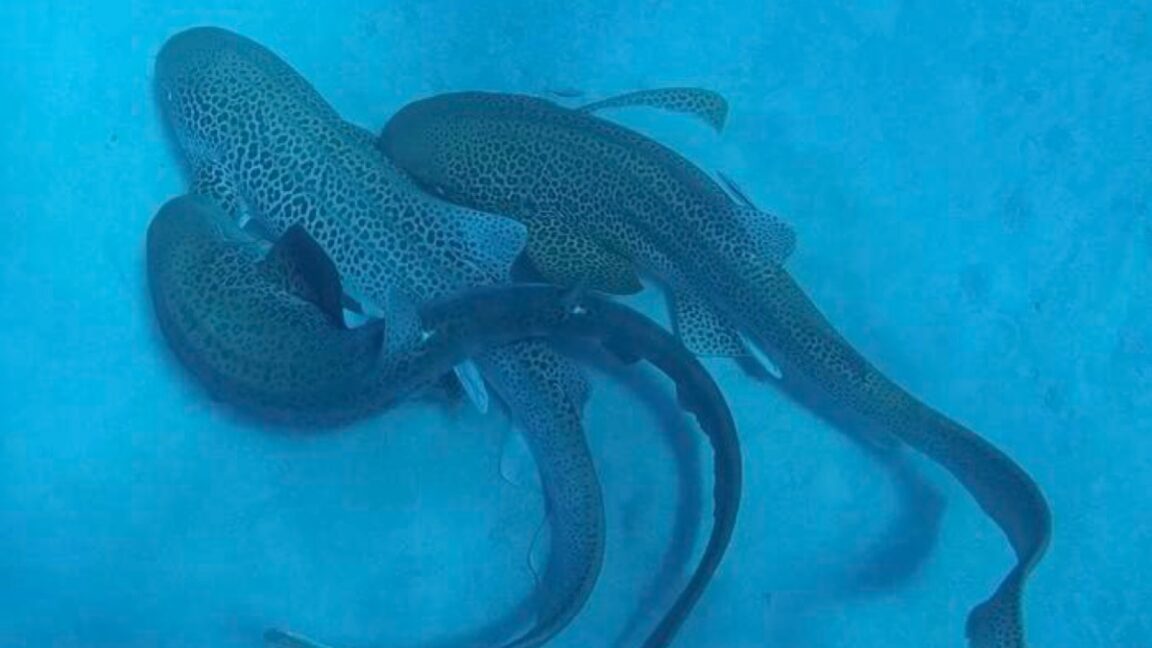Scientists Capture Rare Shark Threesome on Camera, Shedding Light on Endangered Species’ Mating Behavior
In a groundbreaking discovery, marine biologists have successfully recorded a three-leopard-shark mating sequence in the wild, marking a rare occurrence for scientists to witness such behavior. The incident, which took place off the coast of New Caledonia, involved two males and one female shark engaging in what can only be described as a unique mating ritual. This remarkable observation not only sheds new light on the mating habits of leopard sharks but also has significant implications for conservation efforts.
The team of researchers, led by Hugo Lassauce, a postdoctoral researcher at the University of the Sunshine Coast (UniSC) in Australia, had been monitoring shark behavior off the coast of New Caledonia as part of a long-term study. Lassauce, who has spent over a year snorkeling daily with sharks in the area, has gained valuable insights into their behavior and social dynamics. The team’s efforts have paid off, yielding a once-in-a-lifetime opportunity to document this extraordinary event.
Lassauce had been observing the sharks for some time before witnessing the mating sequence unfold. He described the scene as follows: "I was snorkeling with two GoPro Hero 5 cameras ready at hand when I spotted a female shark on the sand below, accompanied by two males hanging onto her pectoral fins." This classic pre-copulation behavior is commonly observed in captive leopard sharks but has rarely been documented in the wild. Lassauce took his time, waiting nearly an hour for the sharks to start moving again.
The male sharks’ mating sequence was both swift and synchronized, with one taking 63 seconds and the other 47 to complete their task. Following the brief encounter, the males lost all energy and lay immobile on the seafloor while the female shark swam away actively. This unusual behavior has sparked curiosity among scientists, who are eager to learn more about the complexities of leopard shark mating habits.
Lassauce’s cameras captured every moment of this extraordinary event, providing a detailed account of the sharks’ movements and interactions. However, the cameras did not run continuously due to battery concerns. Lassauce had to switch between the two cameras, resulting in some minor interruptions to the footage. Despite these limitations, the video provides valuable insights into the mating behavior of leopard sharks.
The documentation of this rare event is a significant achievement for scientists and conservationists alike. As Dr. Christine Dudgeon, co-author of the study, noted: "It’s surprising and fascinating that two males were involved sequentially on this occasion." This unique observation has sparked interest in exploring the genetic diversity of leopard shark populations. By understanding how many fathers contribute to each year’s batches of eggs laid by females, researchers can develop more effective conservation strategies.
The discovery of this critical mating habitat for leopard sharks could lead to better artificial insemination efforts to "rewild" these endangered species in Australia and several other countries. Researchers are eager to build on this groundbreaking finding, exploring the intricacies of shark behavior and social dynamics further.
The Science Behind Shark Mating Behavior
Shark mating rituals are not as well-documented as those of other marine animals. Scientists have primarily relied on observations made in captivity or through indirect methods such as acoustic tracking. However, these approaches often fail to capture the full complexity of shark behavior in their natural habitats.
Leopard sharks, like many other shark species, exhibit complex social behaviors that are still not fully understood. These animals are capable of recognizing and interacting with individual members of their own species, forming long-term pair bonds, and even engaging in cooperative hunting strategies.
The mating behavior observed by Lassauce’s team is a prime example of the intricacies involved in shark reproduction. The sequence begins with a pre-copulation stage where all three sharks are motionless on the seafloor for nearly an hour. This prolonged period allows the female to select her mate, which can be crucial for ensuring genetic diversity.
Once the male has been selected and has finished mating, he lies motionless while the second male holds onto the female’s other fin. The second male then makes his move, and after completing the task, both males swim away soon afterward. This unusual sequence highlights the complexity of shark reproductive behavior and underscores the importance of studying these interactions in their natural habitat.
Conservation Implications
The documentation of this rare mating event has significant implications for leopard shark conservation efforts. By understanding how many fathers contribute to each year’s batches of eggs laid by females, researchers can develop more effective strategies for maintaining genetic diversity within populations.
Artificial insemination programs are already underway in several countries, aiming to "rewild" leopard sharks and restore their populations in the wild. However, these efforts have been hindered by limited understanding of shark mating behavior.
This groundbreaking discovery has shed new light on the importance of preserving natural habitats like the one observed off the coast of New Caledonia. By identifying critical mating areas and protecting them from human impact, conservationists can help safeguard leopard shark populations for generations to come.
Conclusion
The observation of a three-leopard-shark mating sequence in the wild marks a significant breakthrough for scientists studying these endangered species. This rare occurrence has provided valuable insights into shark behavior, shedding light on their complex social dynamics and reproductive habits.
As researchers continue to explore the intricacies of leopard shark mating rituals, they are also drawing attention to the importance of preserving natural habitats. By protecting areas like those observed off New Caledonia, conservationists can help maintain genetic diversity within populations and support the recovery of these magnificent creatures.
This remarkable discovery serves as a testament to the dedication and perseverance of scientists working in the field. As we continue to uncover the secrets of shark behavior, we are reminded of the awe-inspiring complexity and beauty of the natural world, and our responsibility to protect it for future generations.

